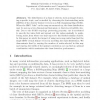Free Online Productivity Tools
i2Speak
i2Symbol
i2OCR
iTex2Img
iWeb2Print
iWeb2Shot
i2Type
iPdf2Split
iPdf2Merge
i2Bopomofo
i2Arabic
i2Style
i2Image
i2PDF
iLatex2Rtf
Sci2ools
WSOM
2009
Springer
2009
Springer
Optimal Combination of SOM Search in Best-Matching Units and Map Neighborhood
Abstract. The distribution of a class of objects, such as images depicting a specific topic, can be studied by observing the best-matching units (BMUs) of the objects’ feature vectors on a Self-Organizing Map (SOM). When the BMU “hits” on the map are summed up, the class distribution may be seen as a two-dimensional histogram or discrete probability density. Due to the SOM’s topology preserving property, one is motivated to smooth the value field and spread out the values spatially to neighboring units, from where one may expect to find further similar objects. In this paper we study the impact of using more map units than just the single BMU of each feature vector in modeling the class distribution. We demonstrate that by varying the number of units selected in this way and varying the width of the spatial convolution one can find an optimal combination which maximizes the class detection performance.
| Added | 27 Jul 2010 |
| Updated | 27 Jul 2010 |
| Type | Conference |
| Year | 2009 |
| Where | WSOM |
| Authors | Mats Sjöberg, Jorma Laaksonen |
Comments (0)

